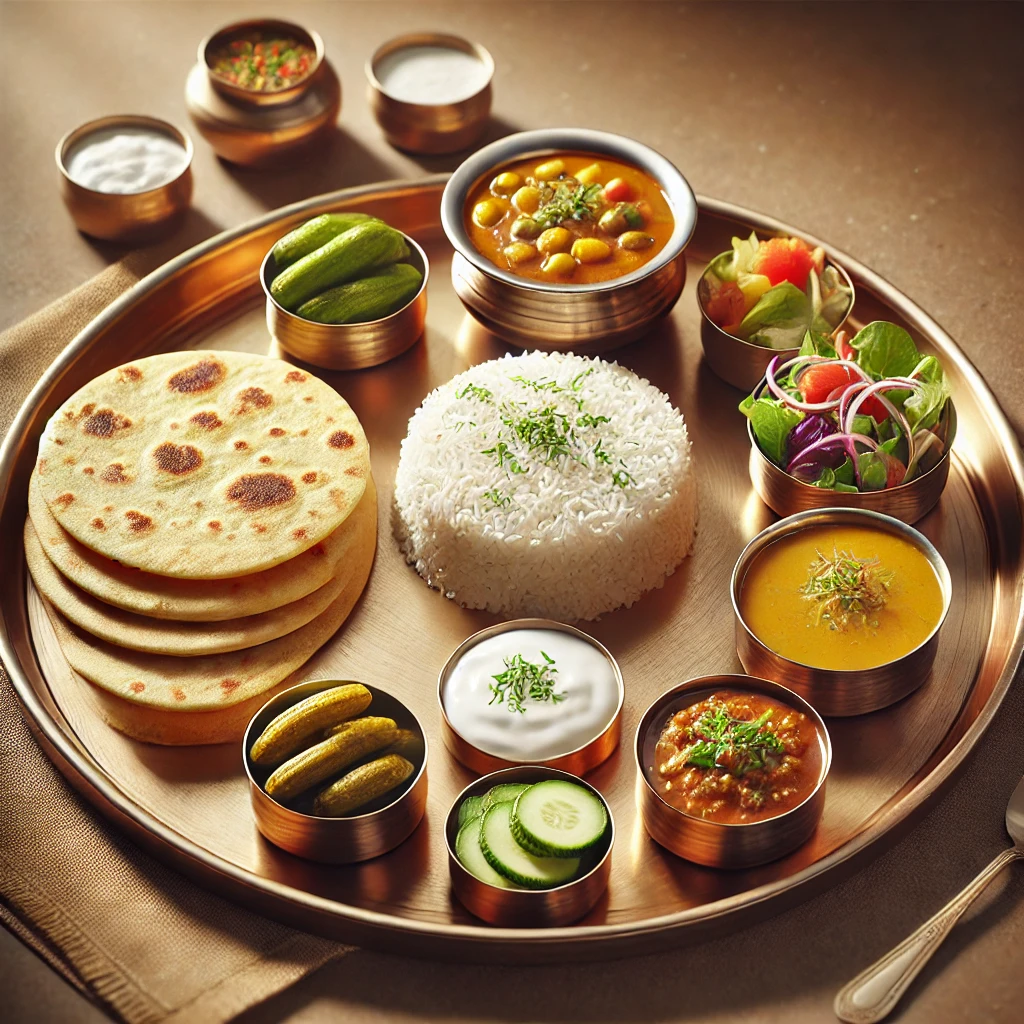Why the Indian thali is considered an Ayurvedic wonder?
Why is the Ayurvedic Indian Thali considered an Ayurvedic wonder?
The traditional Indian thali—whether from North, South, East, or West India—naturally incorporates a balance of the six tastes (Rasas) of Ayurvedic Indian Thali. This diversity of flavors is key to ensuring balanced nutrition, promoting digestive health, and keeping the doshas in harmony.
‘Madhurāmlalavaṇo Tiktaḥ Kaṭukaḥ Kaṣāyaśca Ṣaḍrasāḥ’ six fundamental tastes (Rasas) — sweet, sour, salty, bitter, pungent, and astringent, which play a crucial role in maintaining health and balance in the body according to Ayurvedic Indian Thali. Let's explore how each component of a typical Indian thali exemplifies the six tastes:
- Sweet taste (Madhura)
- In the Thali: Rice, roti, dal, and many vegetables like sweet potatoes and carrots provide the sweet taste. In South Indian cuisine, foods like coconut-based dishes and payasam also bring in sweetness.
- Ayurvedic Understanding: Sweet taste is nourishing and grounding, balancing for Vata and Pitta doshas. It provides energy and builds tissues, making it an essential part of every meal.
- Sour taste (Amla)
- In the Thali: Sour tastes are provided by pickles, yogurt (curd), tamarind-based chutneys, and lemon juice, often added to salads or dal.
- Ayurvedic Understanding: Sour taste stimulates Agni (digestive fire) and improves digestion, while balancing Vata dosha. However, it can aggravate Pitta and Kapha if consumed in excess.
- Salty taste (Lavana)
- In the Thali: Salted dishes like sabzi (vegetable preparations), papad (crispy lentil crackers), or even a sprinkle of salt on salads or curd provide the salty taste.
- Ayurvedic Understanding: Salt helps in electrolyte balance, enhances digestion, and retains moisture in the body. It balances Vata but can aggravate Pitta and Kapha when overused.
- Bitter taste (Tikta)
- In the thali, bitter tastes come from leafy greens like methi (fenugreek), karela (bitter gourd), or medicinal spices such as turmeric in curries.
- Ayurvedic Understanding: Bitter taste is detoxifying and purifying, beneficial for cleansing the blood and reducing Pitta and Kapha doshas. It helps balance excess heat and mucus in the body.
- Pungent taste (Katu)
- In the Thali: The pungent taste is delivered through spices like ginger, garlic, black pepper, chili, mustard, and asafoetida (hing), which are used in tempering dishes like dal, sabzi, or chutneys.
- Ayurvedic Understanding: Pungent taste stimulates digestion and circulation, burning excess fat and detoxifying the body. It balances Kapha but can aggravate Vata and Pitta if overconsumed.
- Astringent taste (Kashaya)
- In the Thali: The astringent taste can be found in legumes such as lentils (dal), beans, chickpeas, and raw vegetables like radish or salads. In South India, foods like banana flower and raw plantains contribute to this taste.
- Ayurvedic Understanding: Astringent taste tones tissues, aids in wound healing, and is balancing for Pitta and Kapha. However, it can increase Vata if eaten in excess, leading to dryness or constipation.
Regional Examples of Balanced Thalis
North Indian Thali:
-
- Sweet: Roti, rice, and dal.
- Sour: Pickle (achar) or yogurt.
- Salty: Vegetables like aloo gobi or paneer sabzi.
- Bitter: Methi (fenugreek) in curries or karela.
- Pungent: Spices like ginger, garlic, and chili in curries.
- Astringent: Lentils like dal tadka, chickpeas (chole), and salads.
South Indian Thali:
-
- Sweet: Rice, coconut chutney, and payasam (dessert).
- Sour: Tamarind-based sambar or rasam.
- Salty: Dosa, idli, or vegetable curries.
- Bitter: Kashayam (herbal decoctions) or bitter gourd curry.
- Pungent: Tempering spices like mustard, chili, and asafoetida in sambar.
- Astringent: Raw banana curry, lentils (dal), and beans.
West Indian Thali (Gujarat/Rajasthan):
-
- Sweet: Thepla, rotla, and sweet chutneys like imli and sonth.
- Sour: Lemon, yogurt, or kadhi (spiced yogurt soup).
- Salty: Dal and papad.
- Bitter: Karela or Methi-based dishes.
- Pungent: Ghee tempering with mustard seeds and red chili.
- Astringent: Beans, lentils (moong), and pulses in curries.
East Indian Ayurvedic Indian Thali (Bengali):
-
- Sweet: Rice, mishti doi (sweet yogurt), or rasgulla.
- Sour: Tomato chutney or tamarind-based preparations.
- Salty: Fish curry or salted vegetables.
- Bitter: Bitter gourd (shukto).
- Pungent: Mustard oil and spices like green chili, ginger.
- Astringent: Moong dal and green leafy vegetables.
The Indian thali is more than just a meal; it is a reflection of Ayurveda’s deep understanding of balance, nutrition, and the interconnectedness of body, mind, and environment. By including all six tastes, balancing doshas, promoting digestion, and aligning with the seasons, the Indian thali is truly an Ayurvedic wonder that supports holistic health and well-being.










 Know your Dosha
Know your Dosha